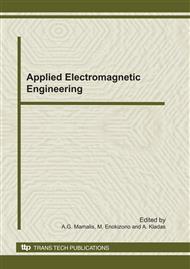[1]
K. Asaka, N. Mori, K. Hayashi, Y. Nakabo, T. Mukai and Z. W. Luo, Modeling of electromechanical response of ionic polymer metal composites (IPMC), Proc. SPIE Smart Mater. Struct., San Diego, 5385, pp.172-181, (2004).
DOI: 10.1117/12.539090
Google Scholar
[2]
K. Asaka, K. Oguro, Y. Nishimura, M. Mizuhara and H. Takenaka, Bending of polyelectrolyte membrane-platinum composites by electric stimuli I, response characteristics to various waveforms, Polym. J., 27, pp.436-440, (1995).
DOI: 10.1295/polymj.27.436
Google Scholar
[3]
Y. Bar-Cohen and S. Leary, Electroactive polymer (EAP) characterization method, Proc. SPIE Smart Mater. Struct., Newport Beach CA, 3987, pp.12-16, (2000).
Google Scholar
[4]
Y. Bar-Cohen, T. Xue, M. Shahinpoor, K. Salehpoor, J. Simpson and J. Smith, Low-mass muscle actuators using electroactive polymers (EAP), Proc. SPIE Smart Mater. Struct., San Diego, 3324, pp.218-223, (1998).
DOI: 10.1117/12.316866
Google Scholar
[5]
K. Iwamoto, G. Tuji, S. Yoshida and M. Seno, Bending behavior of bipolar membranes having a weakly acidic cation exchange membrane, Chem. Soc. Jpn., pp.425-429, (1997).
DOI: 10.1246/nikkashi.1997.425
Google Scholar
[6]
V. K. Nguyen, J. W. Lee and Y. Yoo, Characteristics and performance of ionic polymer-metal composite actuators based on Nafion/layered silicate and Nafion/silica nanocomposites, Sens. Actuators B Chem., 120, pp.529-537, (2006).
DOI: 10.1016/j.snb.2006.03.015
Google Scholar
[7]
K. Oguro, K. Asaka and H. Takenaka, Polymer film actuator driven by a low voltage, Proc. Fourth Internat. Symp. on Micromachine and Human Sci., Nagoya Japan, pp.39-40, (1993).
Google Scholar
[8]
K. Oguro, N. Fujiwara, K. Asaka, K. Onishi and S. Sewa, Polymer electrolyte actuator wit gold electrodes, Proc. SPIE Smart Mater. Struct., Newport Beach CA, 3669, pp.64-71, (1999).
DOI: 10.1117/12.349698
Google Scholar
[9]
K. Oguro, Y. Kawami and H. Takenaka, Bending of an ion-conducting polymer film-electrode composite by an electric stimulus at low voltage, Trans. J. Micromach. Soc., 5, pp.27-30, (1992).
Google Scholar
[10]
S. Popovic, Design of electro-active polymer gels as actuator materials, Ph. D Dissertation, University of Washington, (2001).
Google Scholar
[11]
K. Salehpoor, M. Shahinpoor and M. Mojarrad, Actuators made from ion exchange membrane-metal composites, smart materials technologies, Proc. SPIE Smart Mater. Struct., San Diego, 3040, pp.192-198, (1997).
DOI: 10.1117/12.267128
Google Scholar
[12]
M. Shahinpoor and K. J. Kim, Ionic polymer-metal composites: I. Fundamentals, Smart Mater. Struct., 10, pp.819-833, (2001).
DOI: 10.1088/0964-1726/10/4/327
Google Scholar
[13]
M. Shahinpoor, M. Mojarrad and K. Salehpoor, Electrically induced large amplitude vibration and resonance characteristics of ionic polymeric membrane-metal composite artificial muscles, Proc. SPIE Smart Mater. Struct., San Diego, 3041, pp.829-838, (1997).
DOI: 10.1117/12.275707
Google Scholar
[14]
M. Le Guilly, C. Xu, V. Cheng, M. Taya, L. Opperman and Y. Kuga, Flemion based actuator for mechanically controlled microwave switch, Proc. SPIE Smart Mater. Struct., San Diego, 5051, pp.362-371, (2003).
DOI: 10.1117/12.484402
Google Scholar
[15]
Y. Onouchi, M. Sasaki and H. Tamagawa, Current-controlled Selemion bending in the controlled humidity environment, Sens. Actuators B Chem., 135, pp.465-471, (2009).
DOI: 10.1016/j.snb.2008.10.025
Google Scholar
[16]
H. Tamagawa, S. Goto and T. Sugiyama, Bending direction of Ag-plated IPMC containing immobile anions and/or cations, Composites Science and Technology, 68, pp.3412-3417, (2008).
DOI: 10.1016/j.compscitech.2008.09.031
Google Scholar
[17]
H. Tamagawa and F. Nogata, Bending response of dehydrated ion exchange polymer membranes to the applied voltage, J. Membrane Sci., 243, pp.229-234, (2004).
DOI: 10.1016/j.memsci.2004.06.024
Google Scholar
[18]
H. Tamagawa and F. Nogata, Dominant factor for the precise bending control of Selemion, Sens. Actuators B Chem., 120, pp.19-24, (2006).
DOI: 10.1016/j.snb.2006.01.036
Google Scholar
[19]
H. Tamagawa and F. Nogata, Atomic structural change of silver-plating layers on the surfaces of Selemion, resulting in its excellent bending controllability, Sens. Actuators B Chem., 114, pp.781-787, (2007).
DOI: 10.1016/j.snb.2005.07.043
Google Scholar
[20]
H. Tamagawa and F. Nogata, Charge and water in need for the precise control of Selemion bending, Sens. Actuators B Chem., 121, pp.469-475, (2007).
DOI: 10.1016/j.snb.2006.04.072
Google Scholar
[21]
H. Tamagawa, F. Nogata and S. Popovic, Roles of Ag redox reaction and water absorption inducing the Selemion bending, J. Membrane Sci., 25, pp.145-150.
DOI: 10.1016/j.memsci.2004.11.010
Google Scholar
[22]
H. Tamagawa, F. Nogata and M. Sasaki, Charge quantity as a sole factor quantitatively governing curvature of Selemion, Sens. Actuators B Chem., 124, pp.6-11, (2007).
DOI: 10.1016/j.snb.2006.11.038
Google Scholar
[23]
H. Tamagawa, H. Watanabe and M. Sasaki, Bending direction change of IPMC by the electrode modification, Sens. Actuators B Chem., 140, pp.542-548, (2009).
DOI: 10.1016/j.snb.2009.04.054
Google Scholar


